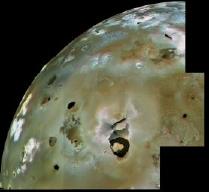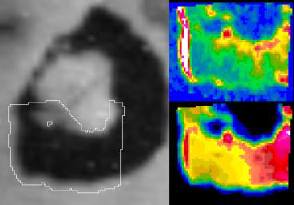LOKI
 Loki
is the most powerful volcano in the solar system, and
consistently emits more heat than all of Earth's volcanoes
combined. Loki has an enormous caldera, larger than the
state of Maryland, which is continually flooded with lava.
Lava temperatures recorded at the Loki hot spot are similar
to those of basaltic lavas on Earth.
Loki
is the most powerful volcano in the solar system, and
consistently emits more heat than all of Earth's volcanoes
combined. Loki has an enormous caldera, larger than the
state of Maryland, which is continually flooded with lava.
Lava temperatures recorded at the Loki hot spot are similar
to those of basaltic lavas on Earth.

Active lava and lava that is still cooling cover the floor of the Loki caldera and surround a light-colored island. With the exception of a narrow crack in the center of the island where high temperatures indicate volcanic activity, the rest of the island appears to be cold. Current volcanic activity can be seen in this temperature map. The yellow regions correspond to temperatures of about 87 degrees Celsius (188 degrees Fahrenheit ), and the red areas record temperatures of about 157 degrees Celsius (314 degrees Fahrenheit). The hottest temperatures correspond to the white areas. Here temperatures reach upwards of 567 degrees Celsius (1053 degrees Fahrenheit).
Scientists are still trying to determine what kind of volcano Loki is. The high temperatures on the western edge of the caldera support the idea that it is an active lava lake with molten material beneath the crust. In volcanic calderas on Earth, such as Hawaii's Kilauea volcano, the crust that forms on the surface as the lava cools tends to drift outward, eventually hitting the caldera wall. Upon striking the wall, the crust breaks up causing hotter material from below the surface to be exposed.
Photo Credits: NASA/JPL
